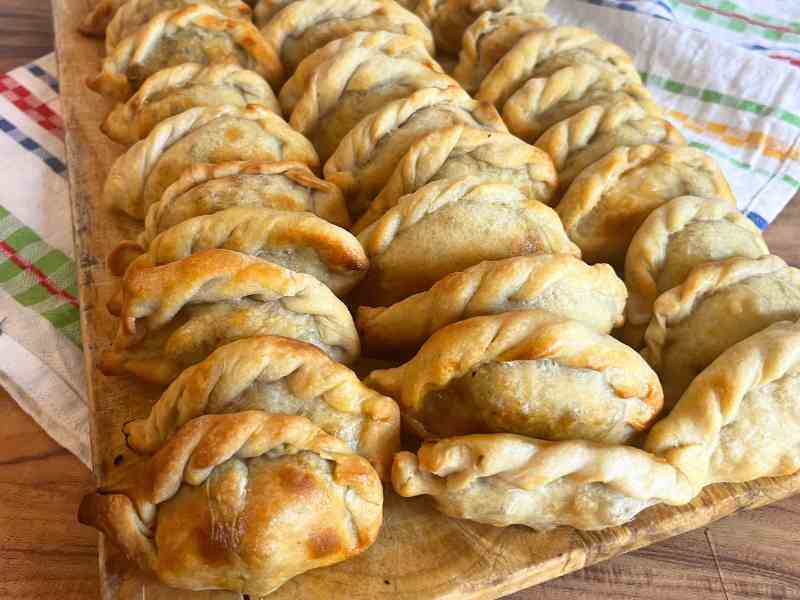
How to Make Cretan Spinach and Cheese Pies: Kalitsounia
Flaky, fragrant, and filled with the green freshness of herbs and soft cheeses, Cretan spinach and cheese pies—kalitsounia—are a cherished staple of the island’s home cooking. Baked or fried, they bring together some of the most beloved local ingredients in one deeply satisfying bite.
Join the My Cretan Recipe Facebook group.
A Classic Recipe with Many Faces
In Cretan kitchens, there are countless ways to prepare kalitsounia. Some households make them with wild greens gathered from the hills, others with tender spring onions and cultivated spinach.

Many prefer a variation known as “anámikta” (mixed pies), combining soft white cheese like myzithra or feta with greens and herbs.
Ricotta Tip
Strain ricotta overnight to obtain a kind of cheese that’s similar to fresh mizithra — perfect for Cretan pies, pastries, or savory fillings. Want to learn more? Check out our full guide: How to Replace Mizithra .
These are also called spanakotiropitakia—a name you might recognize from the mainland as well, though the Cretan version carries a distinct identity.

In Chania, for instance, it’s customary to mix myzithra (a fresh goat cheese) with spinach or other wild greens, mint, dill, and green onions.
The cheese softens the taste of the greens and brings balance to the earthy flavors. The pies can be shaped into squares or folded into half-moons; the first are usually baked, the latter fried in olive oil.


Whichever shape or filling combination you choose, they all start with one essential component: the dough.
The Dough Makes the Pie

A good kalitsouni needs a tender dough, yet sturdy enough to hold a generous spoonful of filling. You can use ready-made phyllo pastry (prefer the country-style that’s a bit thicker), but if you want to follow tradition, we recommend you prepare it yourself.
See our full step-by-step recipe here: How to Make Village-Style Phyllo Dough for Cretan Pies. It’s easy to work with, doesn’t stick thanks to the olive oil, and can be rolled by hand or with a pasta machine for an ultra-thin finish.
>> If you’re interested in the cheese-only version, take a look at our Cretan Cheese Pies: Kalitsounia recipe for more inspiration.
Preparing the Dough and Filling: A Closer Look

Making kalitsounia is as much about the technique and rhythm of preparation as it is about the ingredients. The dough, made from simple pantry staples and flavored with tsikoudia (a Cretan grape spirit) and olive oil, needs to rest so the gluten relaxes.
The rest makes rolling easier and results in a tender yet resilient phyllo sheet that holds the filling without tearing. Thanks to the olive oil in the dough, it won’t stick to your work surface, making it ideal even for home cooks who don’t have professional tools.


Some prefer to use an Italian pasta machine to roll the dough thinly and evenly, but I prefer rolling by hand with a rolling pin to get a more rustic result. For me, this method works perfectly as well.
The filling is a fresh mix of greens and cheeses that vary from household to household depending on what’s available seasonally. The sautéed onions and fresh herbs infuse the spinach with flavor and soften it before it’s combined with the cheeses and eggs, which bind everything together.


This filling is delicate and moist, so the dough’s texture plays an important role in keeping the pies intact during cooking.
When shaping, the porm is partly practical and partly traditional. Squares are favored for baking because they lie flat and cook evenly, while half-moons are better for frying, sealing the filling securely inside the dough. This versatility allows kalitsounia to suit casual snacks or to be served in more formal gatherings.

Cretan Spinach and Cheese Pies – Kalitsounia Anamikta
Ingredients
Ingredients for the Dough
- 1 kg all-purpose flour
- 1/2 cup ½ cup tsikoudia (raki) or white vinegar, vodka, or grappa
- 1 tsp salt
- 1 cup olive oil extra virgin
- water enough to make it elastic
Ingredients for the Filling
- 1/2 cup olive oil extra virgin
- 1 cup onion grated
- 6 spring onions chopped
- 1/2 cup fresh mint chopped
- 1 cup fresh dill chopped
- 1 kg spinach stems removed, washed, and chopped
- salt and pepper to taste
- 2 eggs
- 700 grams feta cheese crumbled
- 500 grams myzithra (or ricotta, if unavailable)
Eggwash
- 1 egg whisked
- 1 tbsp black sesame seeds for decoration
- 1 tbsp white sesame seeds for decoration
Instructions
Check the dough recipe here
How to Prepare the Filling and Assemble the Pies
- In a large pan, heat the olive oil. Add the grated onion, spring onions, chopped dill, and mint. Sauté for about 5 minutes
- Add the chopped spinach to the pan, stir well, and cook for another 5 minutes. Once wilted, transfer everything to a colander to drain any excess moisture.
- In a large mixing bowl, combine the drained spinach mixture with the crumbled feta, myzithra (or ricotta), eggs, salt, and pepper. Mix well with a spoon until all ingredients are well incorporated.
- Roll out the dough to about 1–2 mm thickness. Cut into rounds or squares.
Shape the Pies
- For baked pies, fold using the square shape, place a spoonful of filling in the center, fold the corners slightly or leave the center open.
- For fried pies, fold into half-moon shapes and press the edges to seal.
Baking or Frying
- To Bake: Preheat your oven to 180°C (350°F). Line a baking tray with parchment paper and lightly oil the surface. Place the shaped pies on the tray, brush the tops with beaten egg, and sprinkle with sesame seeds—white for cheese pies, black for spinach ones, black and white for anamikta pies. Bake for about 30 minutes, or until golden brown.
- To Fry: Heat olive oil in a wide pan. Fry the half-moon pies until golden and crispy on both sides. Drain on paper towels.
- Each method offers a slightly different experience. Baking gives you a light, flakier crust, while frying creates a richer, crispier shell.
Notes
- Baking generally results in fewer calories than frying because frying adds more absorbed oil.
- Frying can add approximately 50–70 calories more per pie, depending on oil absorption.
- Variations in cheese fat content or the amount of oil can affect the total calories.
Sweet or Savory? A Versatile Delight

Though these pies are savory by nature, Cretans have a way of turning them into dessert. Fried cheese pies can be served hot and topped with a drizzle of local thyme honey, making for a sweet and salty dish that’s often enjoyed after lunch or dinner.
Serving Tips and Storage
- These pies are ideal as appetizers or part of a meze spread.
- Serve them warm or at room temperature.
- Pair them with Greek yogurt, olives, or a fresh tomato salad.
- To store, refrigerate cooked pies in an airtight container for 2–3 days.
- To freeze uncooked pies, lay them flat on a tray first, then transfer to freezer-safe bags. Bake or fry straight from frozen—just allow for a few extra minutes of cooking time.
From the green hills of Crete to kitchens around the world, kalitsounia anamikta reflect the beauty of local ingredients and traditional knowledge.
They can be simply filled with greens or enriched with cheese, yet they still bring comfort and flavor to everyday meals and festive gatherings alike.
MORE IDEAS
Pin for Later!
How to Make Cretan Spinach & Cheese Pies



Gabi Ancarola
Gabi is a travel writer who has lived in Crete for over a decade. Through her blog, Crete Insider, she has helped travelers uncover local experiences. Passionate about food and Cretan cuisine, she now attends Greek cooking lessons to bring the island’s flavors straight to your kitchen!
>> Interested in learning to cook in Crete, or discovering all of the top spots to eat in Chania and around the island? Book a food tour or plan your trip with me.













